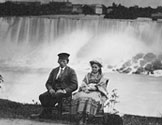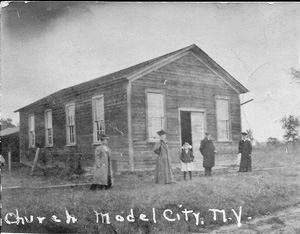

|
||||||||||||||||||||||||||||||||||||||||||
|
| ||||||||||||||||||||||||||||||||||||||||||
 |
 |
 |
 |
 The Dream and Demise of Model City  In the late 19th century, many people wanted to utilize the waters of Niagara Falls to harness hydro-electricity to power industries in the area. One of these visionaries was a man named William T. Love who proposed building a canal between the LaSalle section of Niagara Falls and the Lower Niagara River at Lewiston. Love planned for his canal to pass through the City of Niagara Falls, into Lewiston, through the Tuscarora Reservation, down the escarpment (near the intersection of Rt. 104 and Indian Hill Road), through Lewiston farmland and on to the river below the village. He envisioned a “model” utopian community just below the escarpment where people, businesses and industries would co-exist harmoniously together, all by the benefit of cheap hydro-electric power generated by water tumbling over the mountain ridge. A main thoroughfare would run through this “Model City” with side streets for residential homes and small businesses. Churches, schools and stores were to be built and Love estimated that two million people would someday live in his city. It would also be environmentally friendly, with plenty of green space, and as well as being an alcohol free town. Love’s plan was initially met with great promise and enthusiasm. On May 23, 1894 the first shovelful of dirt was turned for the canal near Cayuga Creek in the City of Niagara Falls. A year later however, only about one mile of Love’s Canal was completed. Progress at Model City was also moving slowly. The 1890s were a time of financial instability in the United States and many of Love’s initial investors had backed away by 1897. Love would then leave the area for long periods of time with the excuse that he was pursuing more investors. It was also at this time, that Nicola Tesla showed the world that alternating current was more efficient than direct current. This meant that electricity could be transmitted to Model City from Niagara Falls without the need of a canal. By then several businesses and industries had located to Model City and continued to operate there with electricity sent from the Falls. William T. Love left the area for good and the last of his property was foreclosed on in 1910. The utopian dream went bust. For the next fifty years locals used the abandoned canal as a swimming hole. Today, Model City consists of only a few homes, a few businesses, a tavern, and the headquarters for Modern Disposal Services, Inc. but it still retains its own Post Office and zip code (14107). The other legacy left by Love was the infamous canal that bore his name. In the 1950s Hooker Chemical began burying toxic waste in the canal. In 1978 the Love Canal story broke leading to the modern environmental movement. Sadly, William T. Love who had dreamed of a peaceful, “green,” utopian community, will forever be linked to an environmental disaster. Douglas Farley, Director Ann Marie Linnabery Erie Canal Discover Center 24 Church St. Lockport NY 14094 716.439.0431 CanalDiscovery@aol.com www.NiagaraHistory.org |